
Token coin
Encyclopedia
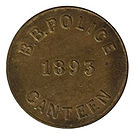
Numismatics
Numismatics is the study or collection of currency, including coins, tokens, paper money, and related objects. While numismatists are often characterized as students or collectors of coins, the discipline also includes the broader study of money and other payment media used to resolve debts and the...
, tokens are coin-like objects used instead of coin
Coin
A coin is a piece of hard material that is standardized in weight, is produced in large quantities in order to facilitate trade, and primarily can be used as a legal tender token for commerce in the designated country, region, or territory....
s. The field of tokens is part of exonumia
Exonumia
Exonumia are numismatic items other than coins and paper money. This includes "Good For" tokens, badges, counterstamped coins, elongated coins, encased coins, souvenir medallions, tags, wooden nickels and other similar items...
. Tokens are used in place of coins and either have a denomination shown or implied by size, color or shape. "Tokens" are often made of cheaper metals: copper
Copper
Copper is a chemical element with the symbol Cu and atomic number 29. It is a ductile metal with very high thermal and electrical conductivity. Pure copper is soft and malleable; an exposed surface has a reddish-orange tarnish...
, pewter
Pewter
Pewter is a malleable metal alloy, traditionally 85–99% tin, with the remainder consisting of copper, antimony, bismuth and lead. Copper and antimony act as hardeners while lead is common in the lower grades of pewter, which have a bluish tint. It has a low melting point, around 170–230 °C ,...
, aluminium
Aluminium
Aluminium or aluminum is a silvery white member of the boron group of chemical elements. It has the symbol Al, and its atomic number is 13. It is not soluble in water under normal circumstances....
, brass
Brass
Brass is an alloy of copper and zinc; the proportions of zinc and copper can be varied to create a range of brasses with varying properties.In comparison, bronze is principally an alloy of copper and tin...
and tin
Tin
Tin is a chemical element with the symbol Sn and atomic number 50. It is a main group metal in group 14 of the periodic table. Tin shows chemical similarity to both neighboring group 14 elements, germanium and lead and has two possible oxidation states, +2 and the slightly more stable +4...
were commonly used, while bakelite, leather
Leather
Leather is a durable and flexible material created via the tanning of putrescible animal rawhide and skin, primarily cattlehide. It can be produced through different manufacturing processes, ranging from cottage industry to heavy industry.-Forms:...
, porcelain
Porcelain
Porcelain is a ceramic material made by heating raw materials, generally including clay in the form of kaolin, in a kiln to temperatures between and...
, and other less durable materials are also known.
The key point of difference between a token and a coin is that a coin is issued by a governmental local or national authority and is freely exchangeable for goods or other coin
Coin
A coin is a piece of hard material that is standardized in weight, is produced in large quantities in order to facilitate trade, and primarily can be used as a legal tender token for commerce in the designated country, region, or territory....
s, whereas a token has a much more limited use and is often (but not always) issued by a private company, group, association or individual.
In the case of "currency tokens" issued by a company but also recognized by the State there is a convergence between tokens and currency. The best known example, the trade tokens of Strachan and Company, were issued in South Africa
South Africa
The Republic of South Africa is a country in southern Africa. Located at the southern tip of Africa, it is divided into nine provinces, with of coastline on the Atlantic and Indian oceans...
in 1874 and are today recognized as that country's first widely circulating indigenous currency.
Currency tokens

Money
Money is any object or record that is generally accepted as payment for goods and services and repayment of debts in a given country or socio-economic context. The main functions of money are distinguished as: a medium of exchange; a unit of account; a store of value; and, occasionally in the past,...
or the governments's inability to issue its own coin
Coin
A coin is a piece of hard material that is standardized in weight, is produced in large quantities in order to facilitate trade, and primarily can be used as a legal tender token for commerce in the designated country, region, or territory....
age. In effect the organization behind the tokens became the regional bank.
One well-known example of currency tokens are the Strachan and Co tokens which were first issued in 1874 in a remote part of South Africa
South Africa
The Republic of South Africa is a country in southern Africa. Located at the southern tip of Africa, it is divided into nine provinces, with of coastline on the Atlantic and Indian oceans...
known as East Griqualand. A partner in Strachan and Co, Charles Brisley, was also the government secretary and obtained official recognition of the tokens as currency for that region. The Standard Bank of South Africa
Standard Bank of South Africa
The Standard Bank of South Africa Limited is one of South Africa's largest financial services groups. It operates in 30 countries around the world, including 17 in Africa.-History:...
notes in its official archives that its branch in Kokstad
Kokstad, KwaZulu-Natal
Kokstad is a town in the Sisonke District of KwaZulu-Natal Province, South Africa. Kokstad is named after the Griqua chief Adam Kok III who settled here in 1863. Stad is the Dutch and Afrikaans word for city....
, East Griqualand's capital, readily exchanged these tokens as currency in the 19th century because of the shortage of coinage of the crown in the region.
Similarly, in times of high inflation, tokens have sometimes taken on a currency role. An example of this is Italian or Israeli telephone tokens, which were always good for the same service (i.e., one phone call) even as prices increased. New York City
New York City
New York is the most populous city in the United States and the center of the New York Metropolitan Area, one of the most populous metropolitan areas in the world. New York exerts a significant impact upon global commerce, finance, media, art, fashion, research, technology, education, and...
subway tokens were also accepted sometimes in trade, or even in parking meters, since they had a set value.
Trade tokens or barter tokens
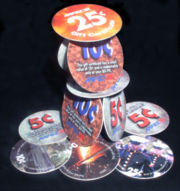
British Isles
The British Isles are a group of islands off the northwest coast of continental Europe that include the islands of Great Britain and Ireland and over six thousand smaller isles. There are two sovereign states located on the islands: the United Kingdom of Great Britain and Northern Ireland and...
and North America
North America
North America is a continent wholly within the Northern Hemisphere and almost wholly within the Western Hemisphere. It is also considered a northern subcontinent of the Americas...
these were commonly issued by merchants in times of acute shortage of coin
Coin
A coin is a piece of hard material that is standardized in weight, is produced in large quantities in order to facilitate trade, and primarily can be used as a legal tender token for commerce in the designated country, region, or territory....
s of the state to enable trading activities to proceed. The token was in effect a pledge redeemable in goods but not necessarily for currency. These tokens never received official sanction from government but were accepted and circulated quite widely.
In England
England
England is a country that is part of the United Kingdom. It shares land borders with Scotland to the north and Wales to the west; the Irish Sea is to the north west, the Celtic Sea to the south west, with the North Sea to the east and the English Channel to the south separating it from continental...
the production of copper farthings was permitted by royal license in the first few decades of the 17th century, but production ceased during the English Civil War
English Civil War
The English Civil War was a series of armed conflicts and political machinations between Parliamentarians and Royalists...
and a great shortage of small change resulted. This shortage was felt more keenly because of the rapid growth of trade in the towns and cities, and this in turn prompted both local authorities and merchants to issue tokens.
These tokens were most commonly made of copper or brass
Brass
Brass is an alloy of copper and zinc; the proportions of zinc and copper can be varied to create a range of brasses with varying properties.In comparison, bronze is principally an alloy of copper and tin...
, but pewter
Pewter
Pewter is a malleable metal alloy, traditionally 85–99% tin, with the remainder consisting of copper, antimony, bismuth and lead. Copper and antimony act as hardeners while lead is common in the lower grades of pewter, which have a bluish tint. It has a low melting point, around 170–230 °C ,...
, lead
Lead
Lead is a main-group element in the carbon group with the symbol Pb and atomic number 82. Lead is a soft, malleable poor metal. It is also counted as one of the heavy metals. Metallic lead has a bluish-white color after being freshly cut, but it soon tarnishes to a dull grayish color when exposed...
and occasionally leather
Leather
Leather is a durable and flexible material created via the tanning of putrescible animal rawhide and skin, primarily cattlehide. It can be produced through different manufacturing processes, ranging from cottage industry to heavy industry.-Forms:...
tokens are also found. Most were not given a specific denomination and were intended to pass as farthings, but there are also a large number of halfpenny and sometimes penny
Penny
A penny is a coin or a type of currency used in several English-speaking countries. It is often the smallest denomination within a currency system.-Etymology:...
tokens. Halfpenny and penny tokens usually, but not always, bear the denomination on their face.
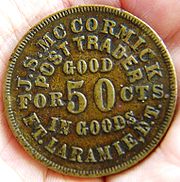
Thousands of towns and merchants issued these tokens between 1648 and 1672, when official production of farthings resumed and private production was suppressed.
Another period of coin shortage occurred in the late 18th century, when the British Royal Mint
Royal Mint
The Royal Mint is the body permitted to manufacture, or mint, coins in the United Kingdom. The Mint originated over 1,100 years ago, but since 2009 it operates as Royal Mint Ltd, a company which has an exclusive contract with HM Treasury to supply all coinage for the UK...
almost ceased production. Merchants once again produced tokens, but they were now machine made and typically larger than their 17th century predecessors with values of a halfpenny or more. While many were used in trade, they were also produced for advertising and political purposes, and some series were produced for the primary purpose of sale to collectors. These tokens are usually known as "Conder" tokens, after the writer of the first reference book on them.
These were issued by merchants in payment for goods with the agreement that they will be redeemed in goods to an equivalent value at the merchants' own outlets. The transaction is therefore one of barter, with the tokens playing a role of convenience, allowing the seller to receive his goods at a rate and time convenient to himself and the merchant to tie the holder of the token coin to his shop. Trade tokens often change slowly and subtly into barter tokens over time, as evidenced by the continued circulation of former trade tokens when the need for their use had passed.
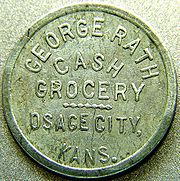
United States Department of the Treasury
The Department of the Treasury is an executive department and the treasury of the United States federal government. It was established by an Act of Congress in 1789 to manage government revenue...
does not ship coins to the Armed Forces serving overseas; so, Army and Air Force Exchange Service
Army and Air Force Exchange Service
The Exchange is an agency of the United States Department of Defense. Its dual missions are to provide quality merchandise and services of necessity and convenience to authorized customers at uniform low prices, and to generate reasonable earnings to supplement appropriated funds for the support...
officials chose to make pogs in denominations of 5, 10 and 25 cent
Cent (currency)
In many national currencies, the cent is a monetary unit that equals 1⁄100 of the basic monetary unit. Etymologically, the word cent derives from the Latin word "centum" meaning hundred. Cent also refers to a coin which is worth one cent....
s. The pogs are about 38mm (1.5816" to be exact) in diameter and feature various military-themed graphics.
The collecting of trade tokens is part of the field of exonumia
Exonumia
Exonumia are numismatic items other than coins and paper money. This includes "Good For" tokens, badges, counterstamped coins, elongated coins, encased coins, souvenir medallions, tags, wooden nickels and other similar items...
, and includes other types of tokens, including transit tokens, encased cents, and many others. In a narrow sense, trade tokens are "good for" tokens, issued by merchants. Generally they have a merchant's name or initials, sometimes a town and state, and a value, such as "good for 5¢" (or other denomination) legend somewhere on the token. Types of merchants that issued tokens included general stores, grocers, department stores, dairies, meat markets, drug stores, saloons, bars, taverns, barbers, coal mines, lumber mills and many other businesses. The era of 1870 through 1920 marked the highest use of "trade tokens" in the United States, spurred by the proliferation of small stores in rural areas. Thousands of small general stores and merchandise stores were to be found all over the United States, and many of them used trade tokens to promote trade and extend credit to customers. Aluminum tokens almost always date after 1890, when low-cost production began.
Slot machine tokens
Metal token coins are used in lieu of cash in some slot machineSlot machine
A slot machine , informally fruit machine , the slots , poker machine or "pokies" or simply slot is a casino gambling machine with three or more reels which spin when a button is pushed...
s in casino
Casino
In modern English, a casino is a facility which houses and accommodates certain types of gambling activities. Casinos are most commonly built near or combined with hotels, restaurants, retail shopping, cruise ships or other tourist attractions...
s.
Money is exchanged for the token coins or chips in a casino at the casino cage, at the gaming tables, or at a slot machine
Slot machine
A slot machine , informally fruit machine , the slots , poker machine or "pokies" or simply slot is a casino gambling machine with three or more reels which spin when a button is pushed...
and at a cashier station for slot token coins. The tokens are interchangeable with money at the casino. They generally have no value outside of the casino.
After the increase in the value of silver stopped the circulation of silver coins around 1964, casinos rushed to find a substitute, as most slot machine
Slot machine
A slot machine , informally fruit machine , the slots , poker machine or "pokies" or simply slot is a casino gambling machine with three or more reels which spin when a button is pushed...
s at that time used that particular coin. The Nevada State Gaming Control Board consulted with the U.S. Treasury, and casinos were soon allowed to start using their own tokens to operate their slot machines. The Franklin Mint
Franklin Mint
The Franklin Mint is a private corporation founded by Joseph Segel in 1964. The private mint operated from Wawa, Pennsylvania but that operation has now closed...
was the main minter of casino tokens at that time.
In 1971, many casinos adopted the Eisenhower Dollar
Eisenhower Dollar
The Eisenhower dollar is a $1 coin issued by the United States government from 1971–1978...
for use in machines and on tables. When the dollar was replaced with the Susan B. Anthony dollar
Susan B. Anthony dollar
The Susan B. Anthony dollar is a United States coin minted from 1979 to 1981, and again in 1999. It depicts women's suffrage campaigner Susan B. Anthony on a dollar coin. It was the first circulating U.S. coin with the portrait of an actual woman rather than an allegorical female figure such as...
in 1979, most casinos reinstituted tokens, fearing confusion with quarters and not wishing to extensively retool their slot machines. Those casinos which still use tokens in slot machines still use Eisenhower-sized ones.
In many jurisdictions, casinos are not permitted to use currency in slot machines, necessitating tokens for smaller denominations.
Tokens are being phased out by many casinos in favor of coinless machines which accept banknotes and print receipts for payout. (These receipts - often nicknamed "TITOs" for ticket in/ticket out, can also be inserted into the machines.)
Staff tokens
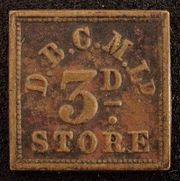
Truck system
A truck system is an arrangement in which employees are paid in commodities or some currency substitute , rather than with standard money. This limits employees' ability to choose how to spend their earnings—generally to the benefit of the employer...
at highly inflated prices—resulting in an effective dramatic lowering of their actual salary and disposable income.
Other sources of tokens
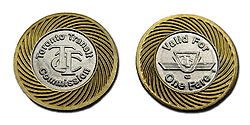
Turnstile
A turnstile, also called a baffle gate, is a form of gate which allows one person to pass at a time. It can also be made so as to enforce one-way traffic of people, and in addition, it can restrict passage only to people who insert a coin, a ticket, a pass, or similar...
s geared only to take tokens (as opposed to coins, currency
Currency
In economics, currency refers to a generally accepted medium of exchange. These are usually the coins and banknotes of a particular government, which comprise the physical aspects of a nation's money supply...
, or fare cards).
- Car washCar washA car wash or auto wash is a facility used to clean the exterior and, in some cases, the interior of motor vehicles.- Categories :...
es - Though their use has decreased in favor of coins and credit cardCredit cardA credit card is a small plastic card issued to users as a system of payment. It allows its holder to buy goods and services based on the holder's promise to pay for these goods and services...
s - Video arcadeVideo arcadeAn amusement arcade or video arcade is a venue where people play arcade games such as video games, pinball machines, electro-mechanical games, redemption games, merchandisers , or coin-operated billiards or air hockey tables...
s - Parking garages
- SubwaysRapid transitA rapid transit, underground, subway, elevated railway, metro or metropolitan railway system is an electric passenger railway in an urban area with a high capacity and frequency, and grade separation from other traffic. Rapid transit systems are typically located either in underground tunnels or on...
- Shopping cart rental
- Public telephone booths in countries with unstable currency were usually configured to accept tokens sold by the telephone company for variable prices. This system was in effect in BrazilBrazilBrazil , officially the Federative Republic of Brazil , is the largest country in South America. It is the world's fifth largest country, both by geographical area and by population with over 192 million people...
until 1997 when magnetic cards were introduced. The practice was also recently discontinued in Israel, leading to a trend of wearing the devalued tokens as necklaces. - Fast foodFast foodFast food is the term given to food that can be prepared and served very quickly. While any meal with low preparation time can be considered to be fast food, typically the term refers to food sold in a restaurant or store with preheated or precooked ingredients, and served to the customer in a...
restaurantRestaurantA restaurant is an establishment which prepares and serves food and drink to customers in return for money. Meals are generally served and eaten on premises, but many restaurants also offer take-out and food delivery services...
s - Often given to children to collect and redeem for prizes - Commemorative coins have been produced with no monetary value to distribute by a company, country or organization.
In North America
North America
North America is a continent wholly within the Northern Hemisphere and almost wholly within the Western Hemisphere. It is also considered a northern subcontinent of the Americas...
tokens were originally issued by merchants from the 18th century in regions where national or local colonial governments did not issue enough small denomination coins for circulation. They were later used to create a monopoly
Monopoly
A monopoly exists when a specific person or enterprise is the only supplier of a particular commodity...
; to pay labor; for discounts (pay in advance, get something free or discounted); or for a multitude of other reasons. In the United States, a well-known type is the wooden nickel
Wooden nickel
A wooden nickel, in the United States, is a wood token coin, which are usually issued by a merchant or bank as a promotion, sometimes redeemable for a specific item such as a drink. Wooden nickels were most commonly issued in the U.S. in the 1930s, after the Great Depression...
, a five-cent
Nickel (United States coin)
The nickel is a five-cent coin, representing a unit of currency equaling five hundredths of one United States dollar. A later-produced Canadian nickel five-cent coin was also called by the same name....
piece distributed by cities to raise money for their anniversaries in the 1940s to 1960s.
Local stores, saloons and mercantiles would issue their own tokens as well, usable only in their own shops. Railways and public transport
Public transport
Public transport is a shared passenger transportation service which is available for use by the general public, as distinct from modes such as taxicab, car pooling or hired buses which are not shared by strangers without private arrangement.Public transport modes include buses, trolleybuses, trams...
agencies have used fare tokens for years to sell rides in advance at a discount. Many transport organizations still offer their own tokens for bus
Bus
A bus is a road vehicle designed to carry passengers. Buses can have a capacity as high as 300 passengers. The most common type of bus is the single-decker bus, with larger loads carried by double-decker buses and articulated buses, and smaller loads carried by midibuses and minibuses; coaches are...
and subway
Rapid transit
A rapid transit, underground, subway, elevated railway, metro or metropolitan railway system is an electric passenger railway in an urban area with a high capacity and frequency, and grade separation from other traffic. Rapid transit systems are typically located either in underground tunnels or on...
services, toll bridges, tunnels, and highways, although the use of computer
Computer
A computer is a programmable machine designed to sequentially and automatically carry out a sequence of arithmetic or logical operations. The particular sequence of operations can be changed readily, allowing the computer to solve more than one kind of problem...
-readable tickets has replaced these in most areas.
Churches used to give tokens
Communion token
A communion token is a metal token issued to members of Presbyterian churches in order to provide them entrance to the Lord's Supper. There were many types issued in Scotland in the 18th and 19th centuries, but they were largely superseded by communion cards....
to members passing a religious test prior to the day of communion
Closed communion
Closed communion is the practice of restricting the serving of the elements of Holy Communion to those who are members of a particular church, denomination, sect, or congregation...
, then required the token for entry. While mostly Scottish Protestant, some U.S. churches used communion tokens. Generally, these were pewter
Pewter
Pewter is a malleable metal alloy, traditionally 85–99% tin, with the remainder consisting of copper, antimony, bismuth and lead. Copper and antimony act as hardeners while lead is common in the lower grades of pewter, which have a bluish tint. It has a low melting point, around 170–230 °C ,...
, often cast by the minister in church-owned molds. Replicas of these tokens have been made available for sale at some churches recently.
See also
- American Vecturist AssociationAmerican Vecturist AssociationThe American Vecturist Association is an organization of transportation token collectors in the United States and Canada, as well as worldwide. Members of the AVA receive the Fare Box, the monthly newsletter of the AVA. The Fare Box contains advertisements, stories, and information about various...
- Civil War tokenCivil War tokenCivil War tokens are token coins that were privately minted and distributed in the United States between 1862 and 1864. They were used mainly in the Northeast and Midwest...
- Numismatic terminologyNumismatic terminologyThis article is a collection of Numismatic and coin collecting terms with concise explanation for the beginner or professional.Numismatics is the scientific study of money and its history in all its varied forms...
- Pub tokenPub tokenPub tokens or bar tokens or chits are a form of exonumia used in drinking establishments.-Usage:...
- Feuchtwanger CentFeuchtwanger CentThe Feuchtwanger Cent is a coin circulated by Lewis Feuchtwanger during the 1830-40s in the U.S.Lewis Feuchtwanger received a doctorate at the University of Jena and then moved to New York City. He was primarily a mineralogist, metallurgist, and chemist, but also worked as a physician and was a...
- Token sucking
- Coins of LundyCoins of LundyThe coins of Lundy are two unofficial issues of currency from the island of Lundy, in the Bristol Channel off the west coast of England. In 1969 Jack Haywood, a British millionaire, purchased the island for £150,000 and gave it to the British people....
- Hard times tokenHard times tokenHard-times tokens are large-cent-sized copper tokens, struck from about 1833 through 1843, serving as unofficial currency. These privately made pieces, comprising merchant, political and satirical pieces, were used during a time of political and financial crisis in the United States.Today,...
- JetonJetonJetons were token or coin-like medals produced across Europe from the 13th through the 17th centuries. They were produced as counters for use in calculation on a lined board similar to an abacus. They also found use as a money substitute in games, similar to modern casino chips or poker chips...
- Medal gameMedal gameMedal games are a type of game commonly found in arcades, especially within Japan. In order to play a medal game a customer must first exchange their cash into medals . The rate of medals versus cash varies from arcade to arcade, but usually the cheapest range is from ¥300 all the way up to ¥10,000...
External links
- The currency tokens of Strachan and Co
- Exonumia
- The Conder Tokens Enthusiast - resources regarding 18th Century English Provincial token coinage
- A reference site on AAFES pogs: tokens currently in use by US armed forces overseas.
- National Museum of Australia 1865 Australian cuprous halfpenny trading token.

